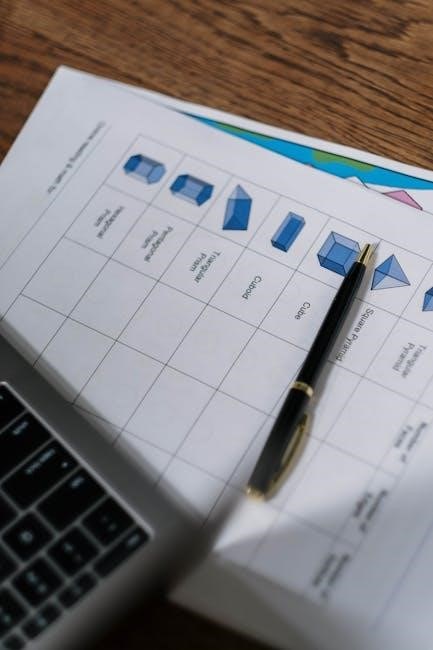Mastering decimal operations is essential for everyday calculations and academic success. Decimals are used in measurements, finance, and science, requiring precise skills for accurate results.
1.1 Importance of Mastering Decimal Operations
Mastering decimal operations is crucial for everyday applications, from measurements to finance. Accurate calculations ensure precision in tasks like budgeting, cooking, and science. Worksheets provide structured practice, helping users apply addition, subtraction, multiplication, and division skills effectively. Regular practice builds confidence and fluency, essential for problem-solving and real-world scenarios. Understanding decimals strengthens foundational math skills, enabling better critical thinking and adaptability in various situations.
Proficiency in decimal operations is vital for academic and professional success. It enhances accuracy in calculations and fosters a deeper understanding of numerical relationships. Worksheets offer a practical way to refine these skills, ensuring mastery and preparedness for more complex mathematical challenges.
1.2 Common Challenges in Decimal Calculations
One of the most common challenges in decimal calculations is aligning the decimal points correctly during addition and subtraction. Misalignment often leads to incorrect results. Another difficulty is remembering to add zeros to numbers with fewer decimal places. Rounding decimals can also be tricky, as it requires understanding place value to determine the correct digit for rounding. Additionally, many struggle with transferring skills from whole numbers to decimals, especially in multiplication and division. These challenges highlight the importance of consistent practice with worksheets to build confidence and accuracy in decimal operations.

Adding and Subtracting Decimals
Adding and subtracting decimals requires aligning decimal points and adding or subtracting as with whole numbers. Always add zeros to numbers with fewer decimal places to ensure accuracy in calculations and maintain consistent place value alignment for correct results.
2.1 Steps to Add Decimals
To add decimals, start by writing the numbers vertically, ensuring the decimal points are aligned. Add zeros to the shorter number to match the number of decimal places. Begin adding from the rightmost digit, moving left, and carry over as needed. After completing the addition, place the decimal point directly below the aligned decimal points in the numbers. This method ensures accuracy and maintains proper place value throughout the calculation, providing the correct sum every time.
2.2 Steps to Subtract Decimals
To subtract decimals, write the numbers vertically, aligning the decimal points. Ensure both numbers have the same number of decimal places by adding zeros to the shorter one. Start subtracting from the rightmost digit, moving left, and borrow from the whole number if necessary. After completing the subtraction, place the decimal point in the result directly below the aligned decimal points. This systematic approach ensures accuracy and maintains proper place value throughout the calculation, providing the correct difference every time.

Multiplying Decimals
Multiplying decimals involves multiplying as if they were whole numbers, then placing the decimal point in the product. Count the total decimal places from both numbers and position the decimal in the result accordingly. This method ensures precise multiplication of decimal values, crucial for accurate calculations in various applications.
3.1 How to Multiply Decimal Numbers
To multiply decimal numbers, follow these steps: First, multiply the numbers as if they were whole numbers, ignoring the decimal points. Next, count the total number of decimal places in both numbers. Finally, place the decimal point in the product so that the number of decimal places matches the total counted. For example, multiplying 2.5 (one decimal place) by 3.2 (one decimal place) gives 8.0 (two decimal places). This method ensures accurate results when multiplying decimals, essential for precise calculations in finance, engineering, and everyday measurements. Practice with worksheets can enhance mastery of this skill.

Dividing Decimals
Dividing decimals involves converting them to whole numbers by multiplying both the dividend and divisor by 10. Perform the division, then place the decimal point correctly in the quotient for accurate results.

4;1 How to Divide Decimals by Whole Numbers
To divide a decimal by a whole number, convert the decimal to a whole number by multiplying both the dividend and the divisor by 10. This eliminates the decimal, making the division straightforward. Perform the division as you would with whole numbers, then place the decimal point in the quotient by counting the number of places you moved the decimal in the dividend. For example, dividing 4.8 by 3 involves converting it to 48 ÷ 3, which equals 16. The decimal point is placed one position from the right, resulting in 1.6. Always ensure the decimal point aligns correctly in the final answer for accuracy. Worksheets with guided steps can help reinforce this method and improve understanding of decimal division.
- Convert the decimal to a whole number by multiplying by 10.
- Perform the division as with whole numbers.
- Place the decimal point correctly in the quotient.

Word Problems Involving Decimals
Word problems involving decimals require applying arithmetic operations to real-world scenarios. Practice worksheets help students solve practical problems, enhancing their ability to interpret and compute decimal-based solutions accurately.
5.1 Solving Real-World Scenarios with Decimals
Solving real-world problems with decimals involves applying arithmetic skills to practical situations. Worksheets provide exercises like calculating total costs, measuring ingredients, or dividing resources. These scenarios help students understand the relevance of decimals in everyday life, such as budgeting, cooking, or construction. By practicing these problems, learners enhance their ability to interpret and compute decimal-based solutions, making them more confident in handling financial and scientific calculations. Worksheets often include word problems that simulate real-life tasks, ensuring a comprehensive understanding of decimal operations.

Tips for Mastering Decimal Operations
Consistent practice and attention to detail are key. Use rounding to simplify problems and align decimal points carefully. Worksheets with exercises can enhance understanding and proficiency.

6.1 Rounding Decimals
Rounding decimals is a crucial skill for simplifying calculations. To round a decimal, identify the rounding digit and examine the next digit to the right. If it is 5 or higher, round up; otherwise, keep the digit the same. For example, 2.45 rounded to the nearest tenth is 2.5, while 12.763 rounded to the nearest hundredth is 12.76. This technique helps in estimating results quickly and accurately. Practice rounding decimals regularly to improve speed and precision in all arithmetic operations, especially when working with multi-step problems.
6.2 Aligning Decimal Points
Aligning decimal points is vital for accurate calculations. When adding or subtracting decimals, write numbers vertically, ensuring the decimal points line up. Add zeros to the shorter number if necessary. For example, to add 2.45 and 12.763, write them as:
2.450
12.763
This alignment prevents errors in placing the decimal point in the result. Always check that decimals are properly lined up before performing any operation. Practice this technique to build confidence and accuracy in decimal arithmetic.

Importance of Practice with Worksheets
Regular practice with worksheets is essential for mastering decimal operations. Worksheets provide structured exercises, reinforcing skills in adding, subtracting, multiplying, and dividing decimals through repeated practice.
7.1 Benefits of Using PDF Worksheets
Premium PDF worksheets offer numerous advantages for learning decimal operations. They are easily downloadable, printable, and accessible offline, making them ideal for self-paced study. Many PDFs are customizable, allowing teachers to tailor exercises to specific skill levels. They often include answer keys for self-assessment, promoting independent learning. PDFs also maintain consistent formatting, ensuring clarity and reducing distractions. With a variety of problems, they cater to different learning styles, providing a comprehensive practice experience for mastering adding, subtracting, multiplying, and dividing decimals. This makes them a valuable resource for both students and educators.

Finding Decimals Worksheets Online
Decimals worksheets are readily available on educational websites, offering a variety of problems for adding, subtracting, multiplying, and dividing decimals. They are easily accessible and printable.
8.1 Recommended Resources for PDF Downloads
Several websites offer high-quality PDF worksheets for decimal operations. Math Worksheets Land provides customizable sheets, while Education.com features interactive exercises. Scribd offers a wide range of free downloadable worksheets, including word problems. These resources are ideal for teachers and students seeking structured practice materials. They cover various skill levels and include answers for easy grading. Printable and editable formats make them versatile for classroom or home use. These platforms are trusted sources for comprehensive decimal operation practice materials.




Leave a Reply
You must be logged in to post a comment.